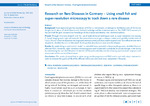Research into rare diseases in Germany - Using small fish and super-resolution microscopy to track down a rare disease
Endlich, Nicole
Background: Focal segmental glomerulosclerosis (FSGS) is a rare disease, or damage to the filtering units of the kidney, the glomeruli, about of which there is only limited knowledge and few treatment options. The STOP-FSGS consortium has set itself the goal to expand our knowledge of this disease and develop new treatment options.
Project: Through intensive research and the use of state-of-the-art techniques such as super-resolution microscopy, AI-based imaging and single-cell research, the consortium aims to gain a deeper understanding of the mechanisms of FSGS. This will allow the disease to be diagnosed more accurately and thus enable targeted and more effective treatment of patients. Another focus is on the search for drugs that slow down or even cure the disease.
Results: By establishing a rapid animal model, i.e. zebrafish larva, potential substances/drugs were identified that can alleviate FSGS. Moreover, super-resolution microscopy was used to precisely quantify the structural changes in the kidney by determining the so-called ‘filtration slit density’ (FSD) and to identify a marker allowing a personalised prognosis and assessment of the course of the disease.
Conclusions: The results obtained help to better recognise the progression of FSGS and to optimally adapt treatment in order to improve the quality of life of the afflicted individuals and avoid renal replacement therapies.
Dateien zu dieser Publikation

